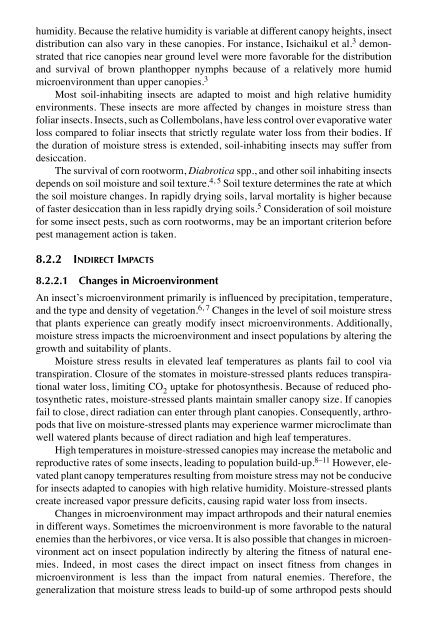Biotic Stress and Yield Loss
Biotic Stress and Yield Loss
Biotic Stress and Yield Loss
- No tags were found...
Create successful ePaper yourself
Turn your PDF publications into a flip-book with our unique Google optimized e-Paper software.
humidity. Because the relative humidity is variable at different canopy heights, insectdistribution can also vary in these canopies. For instance, Isichaikul et al. 3 demonstratedthat rice canopies near ground level were more favorable for the distribution<strong>and</strong> survival of brown planthopper nymphs because of a relatively more humidmicroenvironment than upper canopies. 3Most soil-inhabiting insects are adapted to moist <strong>and</strong> high relative humidityenvironments. These insects are more affected by changes in moisture stress thanfoliar insects. Insects, such as Collembolans, have less control over evaporative waterloss compared to foliar insects that strictly regulate water loss from their bodies. Ifthe duration of moisture stress is extended, soil-inhabiting insects may suffer fromdesiccation.The survival of corn rootworm, Diabrotica spp., <strong>and</strong> other soil inhabiting insectsdepends on soil moisture <strong>and</strong> soil texture. 4, 5 Soil texture determines the rate at whichthe soil moisture changes. In rapidly drying soils, larval mortality is higher becauseof faster desiccation than in less rapidly drying soils. 5 Consideration of soil moisturefor some insect pests, such as corn rootworms, may be an important criterion beforepest management action is taken.8.2.2 INDIRECT IMPACTS8.2.2.1 Changes in MicroenvironmentAn insect’s microenvironment primarily is influenced by precipitation, temperature,<strong>and</strong> the type <strong>and</strong> density of vegetation. 6, 7 Changes in the level of soil moisture stressthat plants experience can greatly modify insect microenvironments. Additionally,moisture stress impacts the microenvironment <strong>and</strong> insect populations by altering thegrowth <strong>and</strong> suitability of plants.Moisture stress results in elevated leaf temperatures as plants fail to cool viatranspiration. Closure of the stomates in moisture-stressed plants reduces transpirationalwater loss, limiting CO 2uptake for photosynthesis. Because of reduced photosyntheticrates, moisture-stressed plants maintain smaller canopy size. If canopiesfail to close, direct radiation can enter through plant canopies. Consequently, arthropodsthat live on moisture-stressed plants may experience warmer microclimate thanwell watered plants because of direct radiation <strong>and</strong> high leaf temperatures.High temperatures in moisture-stressed canopies may increase the metabolic <strong>and</strong>reproductive rates of some insects, leading to population build-up. 8–11 However, elevatedplant canopy temperatures resulting from moisture stress may not be conducivefor insects adapted to canopies with high relative humidity. Moisture-stressed plantscreate increased vapor pressure deficits, causing rapid water loss from insects.Changes in microenvironment may impact arthropods <strong>and</strong> their natural enemiesin different ways. Sometimes the microenvironment is more favorable to the naturalenemies than the herbivores, or vice versa. It is also possible that changes in microenvironmentact on insect population indirectly by altering the fitness of natural enemies.Indeed, in most cases the direct impact on insect fitness from changes inmicroenvironment is less than the impact from natural enemies. Therefore, thegeneralization that moisture stress leads to build-up of some arthropod pests should

















